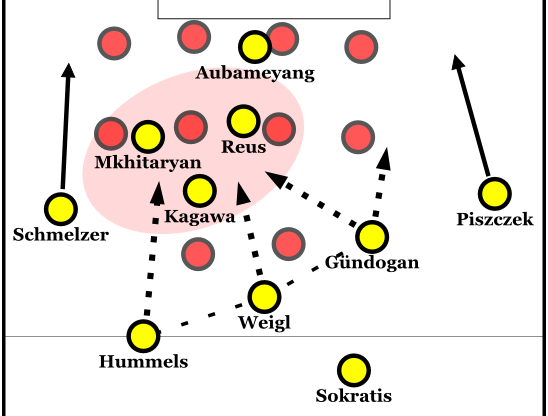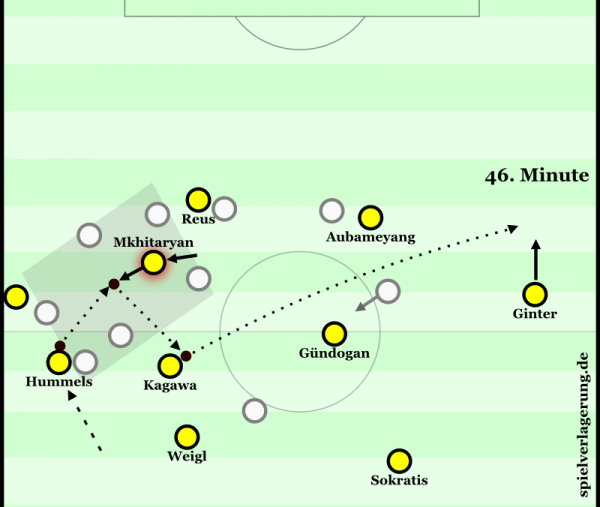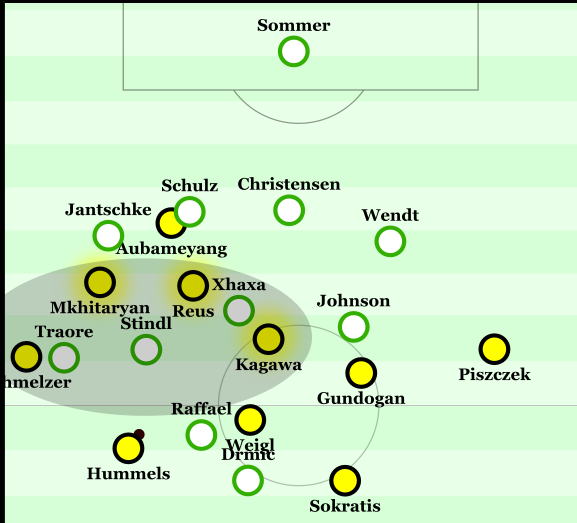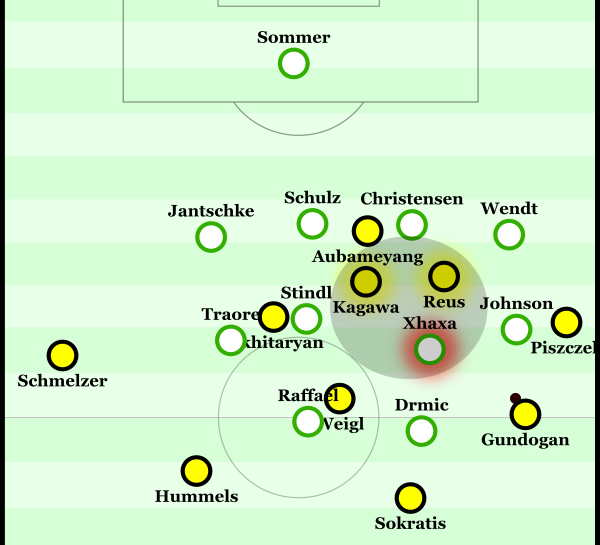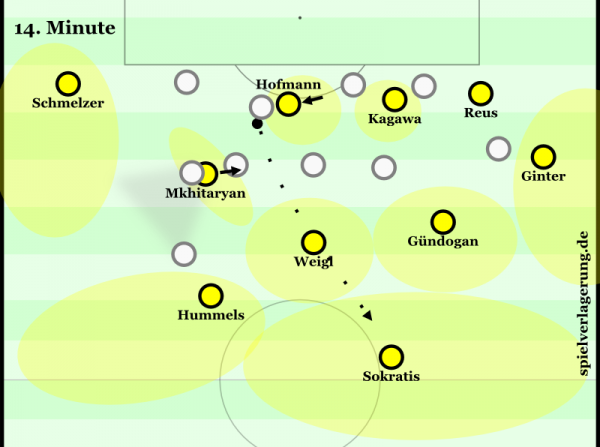Táctica / Alemania / Borussia Dortmund / Fútbol / Modelos de juego / English
Thomas Tuchel’s Positional Play at BVB
Last year BVB was a team in crisis. Klopp’s Dortmund even was dead last after half of the season. Obviously, the situation wasn’t as bad as it looked. There was a ton of bad lucked involved, unsustainable finishing by the opposition and Dortmund would have got better anyways; their play was not much worse than in 2012/13 although after some changes mid-season it was basically a self-fulfilling prophecy. Still Dortmund was able to finish 7th after the end of the season – a massive change.
Nevertheless Klopp in the end quit the club due to exhaustion. His successor was soon found: Thomas Tuchel, the former coach of Mainz, who is considered by many to be Germany’s greatest coaching talent. For him the situation was perfect: After a year which he spent researching football, especially how to play in possession, he had the solutions for BVB’s problems. And he came into a club which would have been better than last season under almost any competent coach. Still they have so far overdone expectations. Why? Because Tuchel is an exceptional coach with a very clear idea. An idea, that resembles JosepGuardiola’s.
JUEGO DE POSICIÓN IN THE BUNDESLIGA
There are not many coaches playing a real Juego De Posición and there are probably a handful of coaches outside of Spain who did it. Tuchel is another one. I once wrote that possession is a tool and not a goal; rarely a team showed that as well as Tuchel’s BVB in the last weeks. It’s especially visible with the two central midfielders who are holding their position very well and just move slightly towards the ball. This is an often underlooked aspect of a positional play.
One of the hidden positives of Juego de Posición is that the players receive the ball in a set position. This gives them not only a clear plan for their actions, the own team’s positional structure in a set situation and about their surroundings, it also enables them to receive the ball without hurry, without exhaustion and against a moving opponent.
Because the opponent gets lured towards one side, they have to move. The positional structure of the team enables good spacing and connections so it’s not only able to play through the opponent who moves but also switch the sides to players who are already in a position to attack and have connections. The opponent has to move there again and until he arrives there, the team which plays Juego de Posición is already set to commit an action with their own rhythm.
At Bayern the two wingers are often the ones who profit from that the most. Key players for BVB to make it work are the two central midfielders. Weigl, who resembles Busquets in some of his strengths, and Gündogan, one of the finest and most complete midfielders in the world when in form, occupy the two half spaces.
ASYMMETRY THROUGH THE MIDDLE
It’s interesting that their positioning is slightly asymmetric. Weigl mostly moves between the left center and the left half space and stays mostly deeper to cover (not only for the players in front of him but also for Hummels when he advances) and give balance, whereas Gündogan is more fixated on the right side and much more active in terms of advancing. Sometimes Gündogan is even positioned high enough to be in a line with Kagawa who drifts towards the left side a bit.
This is important: Weigl covers, Gündogan controls deep and advances towards the right half spaces while Kagawa gives an option upfront between the lines and/or drifts towards the left side. This loosely resembles the structure Barcelona had with Busquets, Xavi and Iniesta starting from 2010 to 2012.
This structure enables them to control with three to four players flexibly in the first two lines in the middle, it gives them the possibility to let Gündogan drop between the right full back and the right center back (the right full back in Piszczek is more potent in attack) or Weigl to drop between the two center backs which in turn gives Hummels, the more creative center back, the possibility to advance.
Schmelzer and Piszczek as full backs are always able to advance with different timing, which makes Mkhitaryan on the left and Reus on the right free to occupy more central positions and again give them the possibility to act as free man or third man in the Juego de Posición.
STRATEGICAL FOCUS ON THE MIDDLE AND TRIANGLES TO PENETRATE
With this they also create triangles in the middle. BVB’s goal is to control the middle and the half spaces (the space of the interiores). They use the wings only to move the opponent to one side before they again play into the middle or the half spaces. Basically, when the opponent closes down the middle or completely opens the wings, these are the only two real reasons for Tuchel’s BVB to play the ball to the sides.
As soon as they are on the sides, they try to advance slightly to win space and then again pass it back to the middle. To be able to pass it towards the middle without being forced back, they create triangles for the full backs. Aubameyang as center forward often goes towards the half space to support as a very high option for a forward pass, where he can lay it off to the two wingers – again utilizing the principle of the third man.
The two center midfielders also support although in deeper zones. The ball near one tries to find open space as free man and receive the ball, before he can verticalize the game again to win space. Mostly it’s the wingers though who create the best options for the full back to pass into the middle. Mkhitaryan or Reus offer an option for a simple horizontal or slightly diagonal forward pass where they turn and use their enormous speed and dribble ability to carry the ball towards the goal. Here is also where Tuchel introduces his own aspects to Juego De Posición.
THE TUCHEL VERSION OF JUEGO DE POSICIÓN IN THE LAST THIRD
Germany mostly focuses on very aggressive movement of the players towards the ball – with and without the ball. Against the ball this is very good as it closes down space, creates a high intensity and just plainly makes it crazily hard to play against them. Counterpressing – the aggressive pressure immediately after losing the ball – is like a German football cliché came to life. And it works.
Offensively, it’s not as good. In counter it sometimes can be very good obviously due to the sheer speed and involvedness this style creates. But in possession often it creates rushed attacks, massive overloads without spacing and connections to other zones and a focus on long balls with high local compactness around it for 2nd balls.
Juego de Posición is entirely different to this. To simplify and abstact it: With Juego de Posición you maintain a balloriented positional structure with specific patterns, movement, concepts and spacing within it, where the goal is to advance the play and win space. This either opens gaps for fast high quality chances or forces the opposing team back while maintaining possession. With this the distance to their goal is smaller and the distance to the own goal bigger.
Still, sometimes it can be hard to penetrate when the opponent is forced extremely deep – or chose to defend with ten players around the own box. Tuchel’s answer to this is simple: They use basics of Juego de Posición to advance the play before they mix it with the German style. For instance in the last third you can see situations where the ballfar winger, Reus or Mkhitaryan, leave their position and create an overload on the other side with the other winger. With this they are able to use extremely fast combinations on small space to advance.
This is a very interesting concept. From the space giving positional structure they are creating extreme dynamic and space punctually in the last third, which surprises opponent and creates breakthroughs towards the opponent’s goal – especially when the creativity of Mkhitaryan and Reus is paired with the sheer speed of Aubameyang.
Compared to last season BVB has a better shot selection, a better way of penetrating (more cutbacks, more lobs and chips, less high crosses, less distance shots, more passes under pressure in the box) and thus is able to convert more of their shots. Add to that their defensive power and you see why BVB might be near the top in all of Europe’s teams right now.
KLOPP’S FUNDAMENTALS SURVIVE WITH A HYBRID SYSTEM AGAINST THE BALL
Despite the introduction of Juego De Posición -like concepts the resemblance to the Klopp’s teams of previous years is uncanny. Pressing, balloriented movement, back four, compactness, high intensity, fast counters (when possible) and great counterpressing are still existant. The things that made Klopp’s teams great are still visible and even profit from the better positional structure in possession. Because they are able to move the opponent back, to win space and to lose the ball in better zones with a better connection within their positional structure their counterpressing might now be better than ever.
Still, there is a change in the phase out of possession slightly different to most of the Klopp era. The BVB is extremely flexible in their press. The base is a 4-2-3-1 but with Gündogan going forward and Kagawa dropping it can be a 4-1-4-1 whenever they want or need to create it. Also both wingers can advance a line higher and make it a 4-1-2-3 or a 4-2-1-3 if needed – for instance against a back three. This flexibility and the better squad – with great additions like sweeper keeper Roman Bürki, Julian Weigl, Gonzalo Castro and now Januzaj and the very underrated Joo-Ho Park (Korea’s left footed answer to Philipp Lahm) – make Tuchel’s Dortmund perhaps the most interesting team in Europe right now.
* Rene Maric is a football analyst on Spielverlagerung.de
– Graphics by @MartinRafelt! Thank you!
Follow @ReneMaric
Follow @MartinRafelt

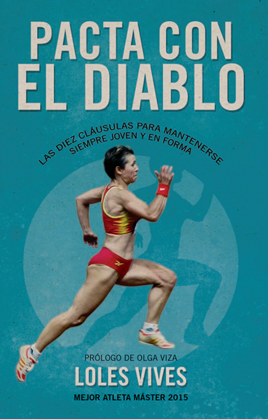
BUSCADOR DE CATEGORÍAS
BUSCADOR POR MES
ÚLTIMOS TWEETS
Tweets por @martiperarnauSÍGUENOS EN FACEBOOK




